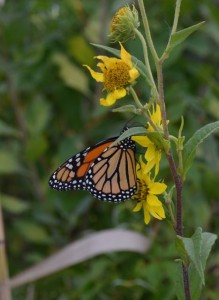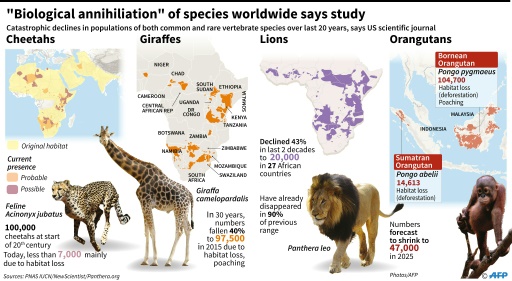On the Path to ‘Ecological Armageddon’
Jan 21st, 2019 | By admin | Category: Biodiversity/ConservationBy Suzanne York.
If you ever question whether or not the world is experiencing the Sixth Mass Extinction, as noted by many scientists, a glance at recent news headlines of species at risk should send convince you we are either in it, or on the precipice. From monarch butterflies to tigers to bats, too many creatures could be gone in a blink of an eye.
Currently, extinctions are happening 1,000 to 10,000 times higher than the natural extinction rate. As documented by World Wildlife Fund, National Geographic, and other conservation organizations, animal populations have declined by more than 50 percent on average in the last two generations.The Human Footprint
One study from Aarhus University found that, since the dawn of humanity, humans have killed off so many species of mammals that it would take 3 million to 7 million years of evolution for them to attain an equivalent amount of diversity.
The top threats to species are directly linked to human activities, including habitat loss, overexploitation of wildlife and natural resources and environmental degradation.
To ask an obvious question, why should we care? Beyond simply having compassion and feelings of guilt for wiping out species for human development, consumption and exploitation, there is the fact that humans are part of the web of life. It is complex, we don’t always fully understand how everything is connected, and we kill off species to our own detriment.
Sadly, we’re going to find out just how that web of life process works when major extinctions occur – nay, are already occurring – whether we’re ready for it or not. See this short article on animals that went extinct in 2018 and this listfor critically endangered animals facing extinction today.
The Decline of Insects
While beautiful and iconic creatures such as tigers, koalas and giraffes can garner concern and perhaps spur people to take action, it is the loss of insects that could have the most dire effect on people and the planet. Over the past few years, scientists and journalists have been noting a major decline in insects. This article from the Guardian paints a depressing yet accurate picture of the global situation:
An insect Armageddon is under way, say many entomologists, the result of a multiple whammy of environmental impacts: pollution, habitat changes, overuse of pesticides, and global warming. And it is a decline that could have crucial consequences. Our creepy crawlies may have unsettling looks but they lie at the foot of a wildlife food chain that makes them vitally important to the makeup and nature of the countryside. They are “the little things that run the world” according to the distinguished Harvard biologist Edward O Wilson, who once observed: “If all humankind were to disappear, the world would regenerate back to the rich state of equilibrium that existed 10,000 years ago. If insects were to vanish, the environment would collapse into chaos.”
While insects are often hated or feared, and people spend tons of money to eradicate ‘pests,’ they are critical to life on Earth. In fact, insects are the dominant life form on Earth. In many ways they are the workhorses of the natural world – pollinating, deposing of dead material, providing waste management services, and numerous other vital ecological services. In the words of Helen Spafford, an applied entomologist, insects are “They’re the unsung heroes of most ecosystems.”
Yet from Europe to North America to Africa to Australia, many individual species and species groups of insects are declining or even being threatened with extinction. Scientists cite many factors in the fall-off of the world’s insect populations, but chief among them are the overuse of pesticides, the spread of monoculture crops such as corn and soybeans, urbanization, and habitat destruction.
Quick facts on insects:
- Insects make up 80 percent of all species on earth
- Scientists have described 1 million species of insects, and estimate at least 4 million are still unrecorded
- 80 percent of wild plants rely on insects for pollination, while around 60 percent of birds rely on them for food.
Prioritizing Nature
What will it mean for our food system if there is a massive decline in insects, especially pollinators, and in turn, pollinating birds that survive eating insects?
Solutions to reverse course include banning pesticides, supporting agroecology,/small-scale farming, addressing climate change, slowing population growth that in turn leads to habitat loss (via support for women’s rights and reproductive rights), and more ambitious concepts such as Nature Needs Half and rights of nature.
We need to act fast and change course now. Efforts to address biodiversity loss and climate change are moving at a glacial pace. The warning signs are everywhere, and multiplying and a dizzying rate.
Over half a century ago, Rachel Carson sounded an alarm about the impact of pesticides on the environment in her instrumental book Silent Spring. It’s not difficult to imagine how saddened she would be of the world today.
In the wise words of Carson, from Silent Spring, “The ‘control of nature’ is a phrase conceived in arrogance, born of the Neanderthal age of biology and philosophy when it was supposed that nature exists for the convenience of man.”
Suzanne York is Director of Transition Earth.


![[photo: creative commons.org]](http://populationgrowth.org/wp-content/uploads/2019/01/bees-e83db0062a_340.jpg)
